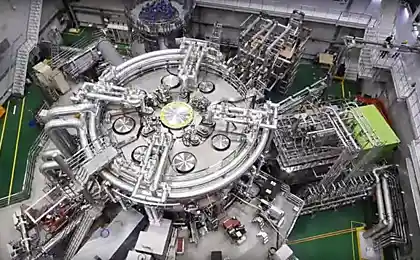861
Storming the sound barrier
Until October 14, 1947, no one could say that a person experiences in the cockpit, flying faster than sound.
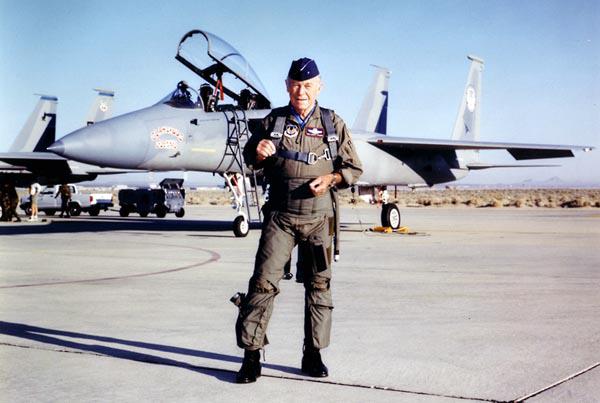
Ten years ago, a veteran of World War II and the Vietnam War a retired Brigadier General Chuck Yeager noted the 50th anniversary of the first supersonic flight of the new supersonic flight on its F-15s. Photo: USAF
October 14th, 1947 mankind has overcome another milestone. Frontier completely objective, expressed in a particular physical quantity - the speed of sound in air, which is under the earth's atmosphere depends on its temperature and pressure in the range 1100-1200 km / h. Supersonic speed to conquer the American pilot Chuck Yeager (Charles Elwood «Chuck» Yeager) - a young veteran of World War II, possess uncommon courage and excellent photogenic, so he immediately became popular in his homeland as well as 14 years later - Yuri Gagarin. And the courage to go through the sound barrier is really needed. Soviet pilot Ivan Fedorov, repeat the achievement Jaeger year later, in 1948, the then recalled his feelings: "Before flying to overcome the sound barrier, it became apparent that guarantees survival after no. Nobody knew almost what it is and whether the design of the aircraft stand the pressure element. But it tried not to think ».
And the courage to go through the sound barrier is really needed. Soviet pilot Ivan Fedorov, repeat the achievement Jaeger year later, in 1948, the then recalled his feelings: "Before flying to overcome the sound barrier, it became apparent that guarantees survival after no. Nobody knew almost what it is and whether the design of the aircraft stand the pressure element. But it tried not to think ».
Indeed, absolute clarity as to how the car will behave at supersonic speed, it was not. In aircraft designers were still fresh in the memories of sudden misfortune 30s, when with increasing speed of the aircraft had to quickly solve the problem of flutter - of oscillation occurring in the hard structure of the aircraft, and its trim, in a few minutes tearing the plane apart. The process of developing an avalanche rapidly, the pilots did not have time to change the flight mode, and the car in the air crumbled to pieces. For a long time mathematicians and engineers in various countries struggled to resolve this problem. In the end, the theory of the phenomena created the then young Russian mathematician Mstislav Keldysh (1911-1978), then President of the USSR. With the help of this theory failed to find a way to get rid of unpleasant phenomenon.

When the aircraft is moving at subsonic speeds, acoustic waves run away from him, like ripples from a stone crashed: pressure near the wavefront changes more or less smoothly. The aircraft, traveling at a speed sverhzukovoy excites shock waves: the pressure on the wave front of this wave changes abruptly. A person standing on the ground heard the sound at first like an explosion - and only then the roar of the motor. Photo: Dr. Leonard Weinstein / DFRC / NASA
It is clear that just as unpleasant surprises expected from the sound barrier. The numerical solution of differential equations of complex aerodynamics in the absence of powerful computers was impossible, and had to rely on the "purging" of models in wind tunnels. But because of quality reasons, it was clear that when the speed of sound near the aircraft, a shock wave. The most crucial moment - breaking the sound barrier, when the speed of the aircraft is compared with the speed of sound. At this point, the pressure difference on either side of the wave front is growing rapidly, and if the time will last longer than a moment, the plane can fall apart at worst by flutter. Sometimes, when breaking the sound barrier with insufficient acceleration of the shock wave created by the aircraft even knocks the glass from the windows of houses on the ground beneath it.
The ratio of the speed of the aircraft to the speed of sound is called Mach number (named after the famous German mechanic and philosopher Ernst Mach). With the passage of the sound barrier, the pilot seems that the number of M jumps through unit abruptly: Chuck Yeager saw the shooter mahometra jumped at 0, 98, 1, 02, and then in the cockpit came the "divine" silence - in fact, apparent: a level the sound pressure in the cabin falls several times. This moment of "purification of sound" is very tricky, it was worth the lives of many testers. But the danger of collapse for its aircraft X-1 was low.
Plane X-1, manufactured by Bell Aircraft in January 1946, was purely a research aircraft, designed to conquer the sound barrier and nothing more. Despite the fact that the machine was ordered by the Ministry of Defense, instead of weapons it bustles scientific equipment, tracking modes units, instruments and mechanisms. X-1 resembled the modern cruise missile. Had one Reaction Motors rocket engine thrust 2722 kg. Maximum take-off weight - 6078 kg. Length - 9, 45 m, height - 3, 3 m, wingspan - 8, 53 m. Maximum speed - at an altitude of 2736 m 18290 km / h. The machine starts with the strategic bomber B-52 and landed on steel "skiing" on the dry salt lake.
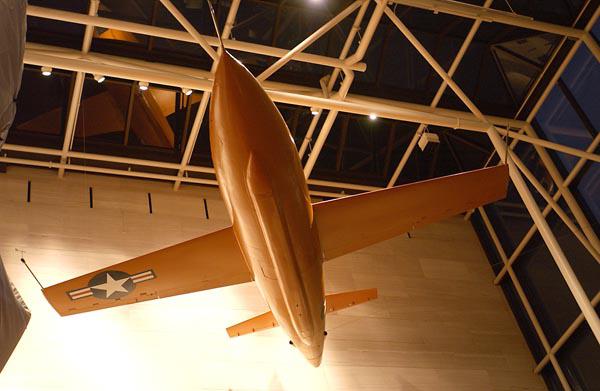
Currently, the aircraft X-1 which Chuck Yeager first broke the sound barrier on display at the National Air and Space Museum (National Air and Space Museum) in Washington. Photo: USAF / Senior Airman J.G. Buzanowski
No less impressive and "tactical and technical parameters" of its pilots. Chuck Yeager was born February 13, 1923. After school he went to flight school, and after graduation went to fight in Europe. He shot down a Messerschmitt-109. Sam was shot down in the skies of France, but was rescued by partisans. As if nothing had happened returned to base in England. However vigilant counterintelligence service did not believe the miraculous deliverance from captivity, pulling the pilot from flying and sent him to the rear. Ambitious Yeager made an appointment with Commander of the Allied forces in Europe, General Eisenhower, who believed Yeager. And it did - a young pilot for six months remain until the end of the war, made 64 sorties, shot down 13 enemy planes and 4 in a single battle. And he returned to his homeland as a captain with a fine file, which means that it has a phenomenal intuition flight, incredible coolness and remarkable endurance in any critical situation. Because of this characteristic, he was in command of test-sverhzvukovikov, which were selected and prepared as thoroughly as later - the astronauts.
Renaming the X-1 "captivating Glenys» (Glamorous Glennis) in honor of his wife, Yeager not once installed it records. At the end of October 1947 it had fallen the previous record height - 21 372 m. In December 1953, a new version of the machine - X-1A has a top speed 2, 35 m - almost 2,800 km / h, and half a year later rose to a height of 27,430 meters. Until that it has been tested a number of launches into a series of running our fighters and MiG-15, captured and trafficked to the United States during the Korean War. Subsequently Yeager commanded various units of the Air Force as a test in the United States and on American bases in Europe and Asia took part in the fighting in Vietnam, trained pilots. In retirement, he was released in February 1975 with the rank of brigadier general, incident during the glorious life of 10 thousand. Hours run-180 supersonic different models and a unique collection of awards and medals. In the mid-80s was shot a film based on the biography of the Good Man, the world's first conquered the sound barrier, and then Chuck Yeager became even a hero and a national relic. The last time he took the helm of the F-16 October 14, 1997 and broke the sound barrier on the fiftieth anniversary of his historic flight. Yeager was then in '74. In general, as the poet said, Nails would make of these people.
There are many people on the other side of the ocean ... Soviet designers Start by trying to conquer the sound barrier at the same time with the US. But for them it was not an end in itself, but the act is quite pragmatic. If the X-1 was purely a research vehicle, we have the sound barrier stormed prototype fighter, which was supposed to launch a series of parts to complete the Air Force.

The MiG-15 were later X-1, partly because the developers put a complex task, and sought not only to overcome the sound barrier, but also to address other technical challenges. As a result, the car was so successful that for a long time its various modifications were in service in different countries. This copy was taken from a South Korean front in the United States, where he "mastered" Chuck Yeager. Photo: USAF
The competition involved several design offices - Lavochkin Design Bureau, OKB Mikoyan and Yakovlev - which were developed in parallel planes with swept wings, which was then a revolutionary design solutions. By the finish they went supersonic in this order: La-176 (1948), the MiG-15 (1949), the Yak-50 (1950). However, there is a problem solved in the context of fairly easy: the war machine must have not only high speed but also a variety of other qualities - maneuverability, survivability, minimum preflight, powerful weapons, ammunition and so impressive etc. It should be noted also that in Soviet times, the decision of the state acceptance commission are often influenced not only by objective factors and subjective factors related to the political maneuvers developers. All this set of circumstances led to the fact that the series was launched by the MiG-15, which is well proven in the local arenas hostilities 50s. That is the car captured in Korea, as mentioned above, "rode" Chuck Yeager.
The La-176 was used at the time a record sweep of the wing, which is equal to 45 degrees. Turbojet VC-1 provides traction 2,700 kg. Length - 10, 97 meters, wingspan - 8, 59 m wing area 18, 26 sq.m. Take-off weight - 4636 kg. Ceiling - 15,000 meters. Flight range - 1000 km. Armament - one 37-mm gun and two 23-mm. The car was ready in the autumn of 1948, in December, it began flight tests in the Crimea at a military airfield near the city of Salem. Among those who led the trials was the future academician Vladimir Struminsky (1914-1998), the pilot of the experimental airplane was captain Oleh Sokolovsky and Colonel Ivan Fedorov, later received the title of Hero of the Soviet Union. Sokolovsky by ridiculous accident died during the fourth flight, forgetting to close the canopy.
Sound barrier Colonel Ivan Fedorov crossed December 26, 1948. After rising to a height of 10 thousand. Meters, he dismissed the control handle on my own and started to accelerate in a dive. "From a great height disperse his 176th - recalled the pilot. - I heard a tedious low whistle. Increasing the speed of the plane hurtling to the ground. On a scale mahometra arrow with triple-digit moves to four digits. The plane shakes as if in a fever. And then - silence! Taken sound barrier. Subsequent decoding waveforms showed that the number of M passed for one. " It happened at an altitude of 7000 meters, where the rate was fixed 1 02M.
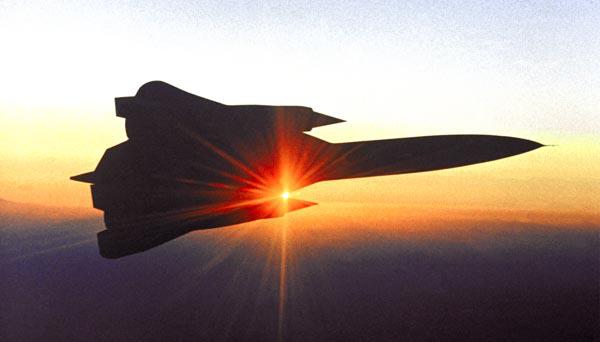
Already the first flight of the aircraft YF-12C in 1962 put an end to the debate about the benefits of swept wings. He served as the prototype for the SR-71 aircraft with a sweep of 60 °, set several records and three times exceeded the speed of sound. After that benefits swept wings began to seem obvious. Photo: DFRC / NASA
In the future, the rate of manned aircraft continued steadily increased due to the increase in engine power, the use of new materials and the optimization of aerodynamic parameters. However, this process is not unlimited. On the one hand, it is hampered by considerations of rationality that takes into account fuel consumption, cost of development, safety and other considerations are not idle. And even in military aircraft where the money and the safety of the pilot is not so significant, the rate of the most "frisky" cars are in the range of 1 to 5M 3M. More as if not required. (Speed record for manned aircraft with jet engines owned by a US spy plane and the SR-71 is 3, 2M.)
On the other hand, there is a thermal barrier insurmountable: the heating speed of the machine housing air friction occurs so quickly that it is impossible to heat dissipation from the surface. Calculations show that at normal pressure, it should take place at a speed of about 10M.
However, a limit of 10M still been made all in the same range Edwards. This happened in 2005. The record became a drone aircraft missile X-43A made within 7 years of an ambitious program Hiper-X technology to simulate a new type designed to radically change the face of rocket and space technology of the future. Its cost is $ 230 million. The record was set at a height of 33 thousand. Meters. In bespilotnike used the new system overclocking. Initially, fulfills the traditional solid-fuel missile, with which the X-43A reaches a speed 7M, and then turn on the engine of a new type - a hypersonic ramjet engine (scramjet or skramdzhet), in which the oxidizing agent is a conventional air and fuel is gaseous Hydrogen (downright classical scheme of uncontrolled explosion).
According to the program it was made three unmanned models that after the job was drowned in the ocean. The next step involves the creation of manned vehicles. After their test results will be taken into account when creating a wide variety of "useful" devices. In addition to the needs of aircraft will be created NASA hypersonic military vehicles - bombers, reconnaissance and transport workers. Boeing, which participates in the program Hiper-X, is planning to 2030-2040 years to create a hypersonic airliner with 250 passengers. Understandably, windows that break down at such speeds aerodynamics and can not withstand the heat of heating, it will not. Instead of the intended display windows with video passing clouds.
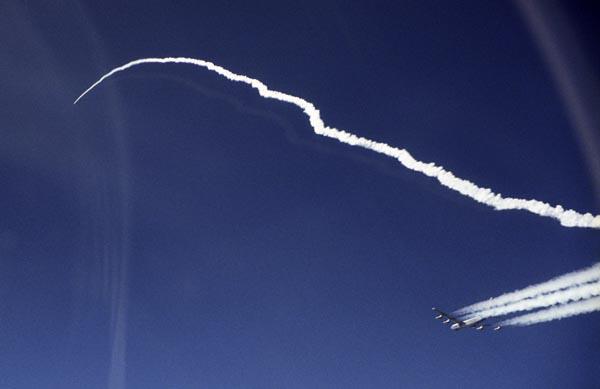
Hypersonic unmanned "skramdzhet" X-43a more than three times higher than the record speed of the SR-71. Driving the flight turned out pretty easy: first bomber build output to a height of 10 000 meters, and then shooting the rocket was accelerated up to 7m, while rising to a height of 30 000m. Next to 10M "skramdzhet" has accelerated itself.
According to the program it was made three unmanned models that after the job was drowned in the ocean. The next step involves the creation of manned vehicles. After their test results will be taken into account when creating a wide variety of "useful" devices. In addition to the needs of aircraft will be created NASA hypersonic military vehicles - bombers, reconnaissance and transport workers. Boeing, which participates in the program Hiper-X, is planning to 2030-2040 years to create a hypersonic airliner with 250 passengers. Understandably, windows that break down at such speeds aerodynamics and can not withstand the heat of heating, it will not. Instead of the intended display windows with video passing clouds.
No doubt, this form of transport will be in demand as more and more expensive over time, accommodating more and more at a time of emotions, earned dollars, and other components of modern life. In this regard, there is no doubt in the fact that someday people will turn into butterflies, one-day, one day will be filled with the entire current (soon - yesterday) human life. And we can assume that someone or something is implementing a program against humanity Hiper-X.

Ten years ago, a veteran of World War II and the Vietnam War a retired Brigadier General Chuck Yeager noted the 50th anniversary of the first supersonic flight of the new supersonic flight on its F-15s. Photo: USAF
October 14th, 1947 mankind has overcome another milestone. Frontier completely objective, expressed in a particular physical quantity - the speed of sound in air, which is under the earth's atmosphere depends on its temperature and pressure in the range 1100-1200 km / h. Supersonic speed to conquer the American pilot Chuck Yeager (Charles Elwood «Chuck» Yeager) - a young veteran of World War II, possess uncommon courage and excellent photogenic, so he immediately became popular in his homeland as well as 14 years later - Yuri Gagarin. And the courage to go through the sound barrier is really needed. Soviet pilot Ivan Fedorov, repeat the achievement Jaeger year later, in 1948, the then recalled his feelings: "Before flying to overcome the sound barrier, it became apparent that guarantees survival after no. Nobody knew almost what it is and whether the design of the aircraft stand the pressure element. But it tried not to think ».
And the courage to go through the sound barrier is really needed. Soviet pilot Ivan Fedorov, repeat the achievement Jaeger year later, in 1948, the then recalled his feelings: "Before flying to overcome the sound barrier, it became apparent that guarantees survival after no. Nobody knew almost what it is and whether the design of the aircraft stand the pressure element. But it tried not to think ».
Indeed, absolute clarity as to how the car will behave at supersonic speed, it was not. In aircraft designers were still fresh in the memories of sudden misfortune 30s, when with increasing speed of the aircraft had to quickly solve the problem of flutter - of oscillation occurring in the hard structure of the aircraft, and its trim, in a few minutes tearing the plane apart. The process of developing an avalanche rapidly, the pilots did not have time to change the flight mode, and the car in the air crumbled to pieces. For a long time mathematicians and engineers in various countries struggled to resolve this problem. In the end, the theory of the phenomena created the then young Russian mathematician Mstislav Keldysh (1911-1978), then President of the USSR. With the help of this theory failed to find a way to get rid of unpleasant phenomenon.

When the aircraft is moving at subsonic speeds, acoustic waves run away from him, like ripples from a stone crashed: pressure near the wavefront changes more or less smoothly. The aircraft, traveling at a speed sverhzukovoy excites shock waves: the pressure on the wave front of this wave changes abruptly. A person standing on the ground heard the sound at first like an explosion - and only then the roar of the motor. Photo: Dr. Leonard Weinstein / DFRC / NASA
It is clear that just as unpleasant surprises expected from the sound barrier. The numerical solution of differential equations of complex aerodynamics in the absence of powerful computers was impossible, and had to rely on the "purging" of models in wind tunnels. But because of quality reasons, it was clear that when the speed of sound near the aircraft, a shock wave. The most crucial moment - breaking the sound barrier, when the speed of the aircraft is compared with the speed of sound. At this point, the pressure difference on either side of the wave front is growing rapidly, and if the time will last longer than a moment, the plane can fall apart at worst by flutter. Sometimes, when breaking the sound barrier with insufficient acceleration of the shock wave created by the aircraft even knocks the glass from the windows of houses on the ground beneath it.
The ratio of the speed of the aircraft to the speed of sound is called Mach number (named after the famous German mechanic and philosopher Ernst Mach). With the passage of the sound barrier, the pilot seems that the number of M jumps through unit abruptly: Chuck Yeager saw the shooter mahometra jumped at 0, 98, 1, 02, and then in the cockpit came the "divine" silence - in fact, apparent: a level the sound pressure in the cabin falls several times. This moment of "purification of sound" is very tricky, it was worth the lives of many testers. But the danger of collapse for its aircraft X-1 was low.
Plane X-1, manufactured by Bell Aircraft in January 1946, was purely a research aircraft, designed to conquer the sound barrier and nothing more. Despite the fact that the machine was ordered by the Ministry of Defense, instead of weapons it bustles scientific equipment, tracking modes units, instruments and mechanisms. X-1 resembled the modern cruise missile. Had one Reaction Motors rocket engine thrust 2722 kg. Maximum take-off weight - 6078 kg. Length - 9, 45 m, height - 3, 3 m, wingspan - 8, 53 m. Maximum speed - at an altitude of 2736 m 18290 km / h. The machine starts with the strategic bomber B-52 and landed on steel "skiing" on the dry salt lake.

Currently, the aircraft X-1 which Chuck Yeager first broke the sound barrier on display at the National Air and Space Museum (National Air and Space Museum) in Washington. Photo: USAF / Senior Airman J.G. Buzanowski
No less impressive and "tactical and technical parameters" of its pilots. Chuck Yeager was born February 13, 1923. After school he went to flight school, and after graduation went to fight in Europe. He shot down a Messerschmitt-109. Sam was shot down in the skies of France, but was rescued by partisans. As if nothing had happened returned to base in England. However vigilant counterintelligence service did not believe the miraculous deliverance from captivity, pulling the pilot from flying and sent him to the rear. Ambitious Yeager made an appointment with Commander of the Allied forces in Europe, General Eisenhower, who believed Yeager. And it did - a young pilot for six months remain until the end of the war, made 64 sorties, shot down 13 enemy planes and 4 in a single battle. And he returned to his homeland as a captain with a fine file, which means that it has a phenomenal intuition flight, incredible coolness and remarkable endurance in any critical situation. Because of this characteristic, he was in command of test-sverhzvukovikov, which were selected and prepared as thoroughly as later - the astronauts.
Renaming the X-1 "captivating Glenys» (Glamorous Glennis) in honor of his wife, Yeager not once installed it records. At the end of October 1947 it had fallen the previous record height - 21 372 m. In December 1953, a new version of the machine - X-1A has a top speed 2, 35 m - almost 2,800 km / h, and half a year later rose to a height of 27,430 meters. Until that it has been tested a number of launches into a series of running our fighters and MiG-15, captured and trafficked to the United States during the Korean War. Subsequently Yeager commanded various units of the Air Force as a test in the United States and on American bases in Europe and Asia took part in the fighting in Vietnam, trained pilots. In retirement, he was released in February 1975 with the rank of brigadier general, incident during the glorious life of 10 thousand. Hours run-180 supersonic different models and a unique collection of awards and medals. In the mid-80s was shot a film based on the biography of the Good Man, the world's first conquered the sound barrier, and then Chuck Yeager became even a hero and a national relic. The last time he took the helm of the F-16 October 14, 1997 and broke the sound barrier on the fiftieth anniversary of his historic flight. Yeager was then in '74. In general, as the poet said, Nails would make of these people.
There are many people on the other side of the ocean ... Soviet designers Start by trying to conquer the sound barrier at the same time with the US. But for them it was not an end in itself, but the act is quite pragmatic. If the X-1 was purely a research vehicle, we have the sound barrier stormed prototype fighter, which was supposed to launch a series of parts to complete the Air Force.

The MiG-15 were later X-1, partly because the developers put a complex task, and sought not only to overcome the sound barrier, but also to address other technical challenges. As a result, the car was so successful that for a long time its various modifications were in service in different countries. This copy was taken from a South Korean front in the United States, where he "mastered" Chuck Yeager. Photo: USAF
The competition involved several design offices - Lavochkin Design Bureau, OKB Mikoyan and Yakovlev - which were developed in parallel planes with swept wings, which was then a revolutionary design solutions. By the finish they went supersonic in this order: La-176 (1948), the MiG-15 (1949), the Yak-50 (1950). However, there is a problem solved in the context of fairly easy: the war machine must have not only high speed but also a variety of other qualities - maneuverability, survivability, minimum preflight, powerful weapons, ammunition and so impressive etc. It should be noted also that in Soviet times, the decision of the state acceptance commission are often influenced not only by objective factors and subjective factors related to the political maneuvers developers. All this set of circumstances led to the fact that the series was launched by the MiG-15, which is well proven in the local arenas hostilities 50s. That is the car captured in Korea, as mentioned above, "rode" Chuck Yeager.
The La-176 was used at the time a record sweep of the wing, which is equal to 45 degrees. Turbojet VC-1 provides traction 2,700 kg. Length - 10, 97 meters, wingspan - 8, 59 m wing area 18, 26 sq.m. Take-off weight - 4636 kg. Ceiling - 15,000 meters. Flight range - 1000 km. Armament - one 37-mm gun and two 23-mm. The car was ready in the autumn of 1948, in December, it began flight tests in the Crimea at a military airfield near the city of Salem. Among those who led the trials was the future academician Vladimir Struminsky (1914-1998), the pilot of the experimental airplane was captain Oleh Sokolovsky and Colonel Ivan Fedorov, later received the title of Hero of the Soviet Union. Sokolovsky by ridiculous accident died during the fourth flight, forgetting to close the canopy.
Sound barrier Colonel Ivan Fedorov crossed December 26, 1948. After rising to a height of 10 thousand. Meters, he dismissed the control handle on my own and started to accelerate in a dive. "From a great height disperse his 176th - recalled the pilot. - I heard a tedious low whistle. Increasing the speed of the plane hurtling to the ground. On a scale mahometra arrow with triple-digit moves to four digits. The plane shakes as if in a fever. And then - silence! Taken sound barrier. Subsequent decoding waveforms showed that the number of M passed for one. " It happened at an altitude of 7000 meters, where the rate was fixed 1 02M.

Already the first flight of the aircraft YF-12C in 1962 put an end to the debate about the benefits of swept wings. He served as the prototype for the SR-71 aircraft with a sweep of 60 °, set several records and three times exceeded the speed of sound. After that benefits swept wings began to seem obvious. Photo: DFRC / NASA
In the future, the rate of manned aircraft continued steadily increased due to the increase in engine power, the use of new materials and the optimization of aerodynamic parameters. However, this process is not unlimited. On the one hand, it is hampered by considerations of rationality that takes into account fuel consumption, cost of development, safety and other considerations are not idle. And even in military aircraft where the money and the safety of the pilot is not so significant, the rate of the most "frisky" cars are in the range of 1 to 5M 3M. More as if not required. (Speed record for manned aircraft with jet engines owned by a US spy plane and the SR-71 is 3, 2M.)
On the other hand, there is a thermal barrier insurmountable: the heating speed of the machine housing air friction occurs so quickly that it is impossible to heat dissipation from the surface. Calculations show that at normal pressure, it should take place at a speed of about 10M.
However, a limit of 10M still been made all in the same range Edwards. This happened in 2005. The record became a drone aircraft missile X-43A made within 7 years of an ambitious program Hiper-X technology to simulate a new type designed to radically change the face of rocket and space technology of the future. Its cost is $ 230 million. The record was set at a height of 33 thousand. Meters. In bespilotnike used the new system overclocking. Initially, fulfills the traditional solid-fuel missile, with which the X-43A reaches a speed 7M, and then turn on the engine of a new type - a hypersonic ramjet engine (scramjet or skramdzhet), in which the oxidizing agent is a conventional air and fuel is gaseous Hydrogen (downright classical scheme of uncontrolled explosion).
According to the program it was made three unmanned models that after the job was drowned in the ocean. The next step involves the creation of manned vehicles. After their test results will be taken into account when creating a wide variety of "useful" devices. In addition to the needs of aircraft will be created NASA hypersonic military vehicles - bombers, reconnaissance and transport workers. Boeing, which participates in the program Hiper-X, is planning to 2030-2040 years to create a hypersonic airliner with 250 passengers. Understandably, windows that break down at such speeds aerodynamics and can not withstand the heat of heating, it will not. Instead of the intended display windows with video passing clouds.

Hypersonic unmanned "skramdzhet" X-43a more than three times higher than the record speed of the SR-71. Driving the flight turned out pretty easy: first bomber build output to a height of 10 000 meters, and then shooting the rocket was accelerated up to 7m, while rising to a height of 30 000m. Next to 10M "skramdzhet" has accelerated itself.
According to the program it was made three unmanned models that after the job was drowned in the ocean. The next step involves the creation of manned vehicles. After their test results will be taken into account when creating a wide variety of "useful" devices. In addition to the needs of aircraft will be created NASA hypersonic military vehicles - bombers, reconnaissance and transport workers. Boeing, which participates in the program Hiper-X, is planning to 2030-2040 years to create a hypersonic airliner with 250 passengers. Understandably, windows that break down at such speeds aerodynamics and can not withstand the heat of heating, it will not. Instead of the intended display windows with video passing clouds.
No doubt, this form of transport will be in demand as more and more expensive over time, accommodating more and more at a time of emotions, earned dollars, and other components of modern life. In this regard, there is no doubt in the fact that someday people will turn into butterflies, one-day, one day will be filled with the entire current (soon - yesterday) human life. And we can assume that someone or something is implementing a program against humanity Hiper-X.















